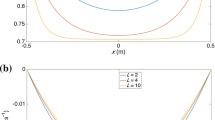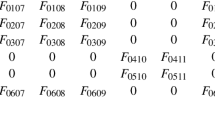Abstract
The central problem of devising mathematical models of granular materials is how to define a granular medium as a continuum. This paper outlines the elements of a theory that could be incorporated in discrete models such as the Discrete-Element Method, without recourse to a continuum description. It is shown that familiar concepts from continuum mechanics such as stress and strain can be defined for interacting discrete quantities. Established concepts for constitutive equations can likewise be applied to discrete quantities. The key problem is how to define the constitutive response in terms of truncated strain measures that are a practical necessity for analysis of large granular systems.
Access this chapter
Tax calculation will be finalised at checkout
Purchases are for personal use only
Preview
Unable to display preview. Download preview PDF.
Similar content being viewed by others
References
H.M. Jaeger, S.R. Nager and R.P. Behringer, The physics of granular media. Physics Today 49 (1996) 32–38.
K.C. Valanis and J.F. Peters, Ill-posedness of the initial and boundary value problems in non-associative plasticity. ACTA Mech. 114 (1996) 1–25.
P.A. Cundal and O.D.L. Strack, A discrete numerical model for granular assemblies. Geotechnique 29 (1979) 47–65.
C.S. Chang and C.L. Liao, Constitutive relation for a particulate medium with the effect of particle rotation. Int. J. Solids Struct. 26 (1990) 437–453.
C.L. Liao, T.C. Chan, A.S.K. Suiker and C.S. Chang, Pressure-dependent elastic moduli of granular assemblies. Int. J. Num. Anal. Methods Geomech. 24 (2000) 265–279.
R.D. Hryciw, S.A. Raschke, A.M. Ghalib, D.A. Horner and J.F. Peters, Video tracking for experimental validation of discrete element simulations of large discontinuous deformations. Computers Geotechn. 21 (1997) 235–253.
D.A. Horner, J.F. Peters and A. Carrillo, Large scale discrete element modeling of vehicle-soil interaction. ASCE J. Eng. Mech. 127 (1979) 1027–1032.
P.A. Cundal, A discrete future for numerical modeling. In: B.K. Cook and R.P. Jensen (eds.), Discrete Element Methods: Numerical Modeling of Discontinua. ASCE Geotechnical Special Publication No. 117. Reston (VA): ASCE (2002) pp. 3–4.
A. Tordesillas and S. Walsh, Incorporating rolling resistance and contact anisotropy in micromechanical models of granular media. Powder Technol. 124 (2002) 106–111.
J.P. Bardet and I. Vardoulakis, The asymmetry of stress in granular media. Int. J. Solids Struct. 38 (2001) 353–367.
B. Bagi, Stress and strain in granular assemblies. Mech. Materials 22 (1996) 165–177.
B. Bagi, Microstructural stress tensor of granular assemblies with volume forces. ASME J. Appl. Mech. 66 (1999) 934–936.
N.P. Kruyt, Statics and kinematics of discrete Cosserat-type granular materials. Int. J. Solids Struct. 40 (2003) 511–534.
J.F. Peters and E. Heymsfield, Application of the 2-D constant strain assumption to FEM elements consisting of an arbitrary number of nodes. Int. J. Solids Struct. 40 (2003) 143–159.
K.C. Valanis and J.F. Peters, An endochronic plasticity theory with shear-volumetric coupling. Int. J. Num. and Anal. Methods Geomech. 15 (1991) 77–102.
K.C. Valanis and C.F. Lee, Endochronic plasticity: physical basis and applications. In: C.S. Desai and R.H. Gallagher (eds.), Mechanics of Engineering Materials. New York: Wiley (1984) pp. 591–609.
D.Z. Zhang and R.M. Raueszahn, Stress relaxation in dense and slow granular flows. J. Rheology 45 (1979) 1019–1041.
Author information
Authors and Affiliations
Editor information
Editors and Affiliations
Rights and permissions
Copyright information
© 2005 Springer
About this chapter
Cite this chapter
Peters, J.F. (2005). Some fundamental aspects of the continuumization problem in granular Media. In: Hill, J.M., Selvadurai, A. (eds) Mathematics and Mechanics of Granular Materials. Springer, Dordrecht. https://doi.org/10.1007/1-4020-4183-7_13
Download citation
DOI: https://doi.org/10.1007/1-4020-4183-7_13
Received:
Accepted:
Publisher Name: Springer, Dordrecht
Print ISBN: 978-1-4020-3781-8
Online ISBN: 978-1-4020-4183-9
eBook Packages: Physics and AstronomyPhysics and Astronomy (R0)




